 |
 |
 |
 |
 |
 |
| |
 |
|
 |
 |
 |
  |
  |
 |
 |
 |
 |
|
|
 |
|
 |
 |
 |
BUILDING |
 |
|
 |
|
 |
 |
 |
| |
 |
| 
 |
Masdar Institute campus
|
|
 |
 |
 |
 |
DESIGNER |
 |
|
|
 |
|
 |
 |
 |
| |
 |
|
 |
 |
 |
 |
DESCRIPTION |
 |
|
|
 |
|
 |
 |
 |
|
|
 |
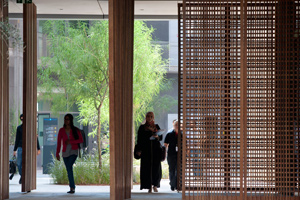 The Masdar Institute, devoted to researching sustainability, is the first building to be fully operational within Masdar City. The masterplan, by Foster + Partners, incorporates lessons which have evolved over centuries of traditional Arabian architecture. The Masdar Institute is the first building of its kind to be powered entirely by renewable solar energy. It will be used as a pilot test bed for the sustainable technologies that will be explored for implementation in future Masdar City buildings. The post graduate students are Masdar City’s first resident community. The Masdar Institute, devoted to researching sustainability, is the first building to be fully operational within Masdar City. The masterplan, by Foster + Partners, incorporates lessons which have evolved over centuries of traditional Arabian architecture. The Masdar Institute is the first building of its kind to be powered entirely by renewable solar energy. It will be used as a pilot test bed for the sustainable technologies that will be explored for implementation in future Masdar City buildings. The post graduate students are Masdar City’s first resident community.
A 10 megawatt solar field within the masterplan site provides 60% more energy than is consumed by the Masdar Institute, the remaining energy is fed back to the Abu Dhabi grid. The campus, which consists of a main building, a knowledge centre and students’ quarters, will use significantly less energy and water than average buildings in the UAE. In particular, the Institute and its facilities use 54 percent less potable water, 51 percent less electricity and are fully powered by solar energy. These reductions are based on comparisons to UAE standard baselines for buildings of similar size and specifications. Around 30 percent of the campus’s energy will be covered by solar panels on the roof, with 75 percent of hot water also being heated by the sun.
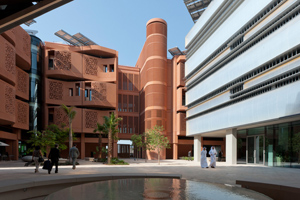 The Institute demonstrates the sustainable principles underpinning the overall masterplan. The buildings have self-shading facades and are orientated to provide maximum shade as well as sheltering adjacent buildings and the pedestrian streets below. Over 5,000 square metres of roof mounted photovoltaic installations provide power and additional shading at street level. Windows in the residential buildings are protected by a contemporary reinterpretation of mashrabiya, a type of latticed projecting oriel window, constructed with sustainably developed, glass-reinforced concrete, coloured with local sand to integrate with its desert context and to minimise maintenance. The perforations for light and shade are based on the patterns found in the traditional architecture of Islam. The Institute demonstrates the sustainable principles underpinning the overall masterplan. The buildings have self-shading facades and are orientated to provide maximum shade as well as sheltering adjacent buildings and the pedestrian streets below. Over 5,000 square metres of roof mounted photovoltaic installations provide power and additional shading at street level. Windows in the residential buildings are protected by a contemporary reinterpretation of mashrabiya, a type of latticed projecting oriel window, constructed with sustainably developed, glass-reinforced concrete, coloured with local sand to integrate with its desert context and to minimise maintenance. The perforations for light and shade are based on the patterns found in the traditional architecture of Islam.
The laboratories are unusually flexible for change with ‘plug and play’ services to encourage interdisciplinary research. Horizontal and vertical fins and brise soleil shade the laboratories. These are highly insulated by facades of inflatable cushions, which remain cool to the touch under the most intense desert sun. Cooling air currents are channelled through the public spaces using a contemporary interpretation of the region’s traditional windtowers. The public spaces are further cooled by green landscaping and water to provide evaporative cooling. Thermal camera tests on-site by Fosters’ research team have already confirmed substantial drops in radiant or ‘felt’ temperatures on campus compared with current practice in central Abu Dhabi.
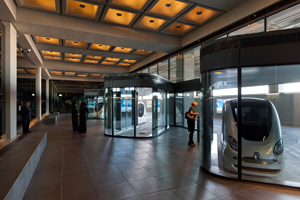 The laboratories and residential accommodation are supported by a variety of social spaces, including a gymnasium, canteen, café, knowledge centre, majlis – or meeting place – and landscaped areas that extend the civic realm and help to create a new destination within the city. One, two and three-bedroom apartments are housed in low-rise, high-density blocks, which act as a social counterpoint to the educational laboratory environment. The laboratories and residential accommodation are supported by a variety of social spaces, including a gymnasium, canteen, café, knowledge centre, majlis – or meeting place – and landscaped areas that extend the civic realm and help to create a new destination within the city. One, two and three-bedroom apartments are housed in low-rise, high-density blocks, which act as a social counterpoint to the educational laboratory environment.
This building is the first of four planned phases that will bring the eventual student population to 600-800. Four residential blocks surround a central laboratory and the Knowledge Centre, the first in a series of additional campus buildings, which will include a mosque, conference hall and sports complex. The second phase is due to start on site by the end of the year to include further laboratories and apartments. The Masdar Institute is accessed by 10 personal rapid transit (PRT) cars that are being run as a pilot project from the City perimeter to the undercroft below the building.
This project signals Abu Dhabi’s commitment to creating an international centre to pioneer sustainable technologies within an environment which is itself carbon neutral.
Edit by Foster + Partners |
|
 |
 |
 |
 |
 |
 |
 |
ECO-SUSTAINABILITY |
 |
|
|
 |
|
 |
 |
 |
| Features of energy |
 |
|
 |
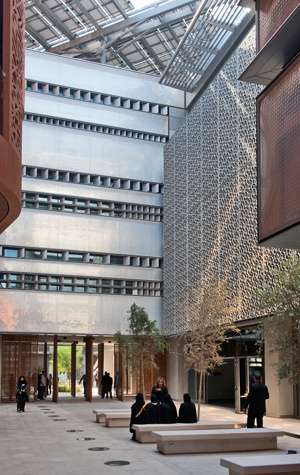 The Masdar Institute’s graduate-level programmes were established and accredited in collaboration with the Massachusetts Institute of Technology (MIT) in Boston and focus on scientific engineering and research in the core energy and sustainable technologies of the Masdar Initiative. The Masdar Institute’s graduate-level programmes were established and accredited in collaboration with the Massachusetts Institute of Technology (MIT) in Boston and focus on scientific engineering and research in the core energy and sustainable technologies of the Masdar Initiative.
 The buildings are oriented to provide optimum shade and reduce cooling loads and shaded colonnades at podium level bring benefits through high insulation and exposed thermal mass. Transitional thermal spaces are also integrated – these mediate between internal and external zones and are conditioned primarily by buoyancy-driven natural ventilation and the effects of thermal mass. The buildings are oriented to provide optimum shade and reduce cooling loads and shaded colonnades at podium level bring benefits through high insulation and exposed thermal mass. Transitional thermal spaces are also integrated – these mediate between internal and external zones and are conditioned primarily by buoyancy-driven natural ventilation and the effects of thermal mass.
The ventilation strategy for the pedestrian streets and night time cooling is further enhanced by wind towers and courtyards. Pedestrian circulation is mostly at street level, where a shaded route throughout the campus links these primary spaces.
The green linear park adjacent to part of the buildings captures cooling night-time winds, while wind gates control hot winds. The public spaces within the development are designed as lively social hubs, naturally cooled by shading, green planting and a small number of water features, to mitigate the effects of the intense local climate.
The ratio of open facades is varied between shaded lower areas and exposed upper areas. Openings in the façade vary according to their position – the upper floors are more solid, with approximately 25 percent glass, while the shaded lower floors have a greater proportion of glazed area, around 45 percent.
The laboratory facades incorporate ETFE, inflatable cushions made of a lightweight polymer, and have been designed to filter and reflect light into the street, without radiating heat.
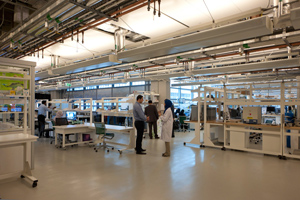 The laboratories – and an interactive laboratory space – are at the heart of the development and are designed to offer the largest flexible, column free space possible within the strict loading and vibration criteria. Support facilities are arranged in a functionally efficient, linear layout adjacent to the open laboratories and a central café creates an informal space for researchers and staff to meet. The laboratories – and an interactive laboratory space – are at the heart of the development and are designed to offer the largest flexible, column free space possible within the strict loading and vibration criteria. Support facilities are arranged in a functionally efficient, linear layout adjacent to the open laboratories and a central café creates an informal space for researchers and staff to meet.
All sewage is processed on site and recycled.
Mashrabiya is the Arabic term given to a type of projecting oriel window which was traditionally enclosed with carved wood latticework. Referencing traditional Arabic architecture, it is used primarily on the street-facing aspect of the building. |
|
 |
 |
 |
 |
 |
 |
 |
LOCATION |
 |
|
|
 |
|
 |
 |
 |

|
 |

|
Continent |
|
 |
  Asia |
|
Nation |
|
 |
  United Arab Emirates [Al-Imarat al-'Arabiya al Muttahida] |
|
Emirate |
|
 |
  Abu-Dhabi [Abū Ẓabī] |
|
Town |
|
 |
  Abu-Dhabi [Abū Ẓabī] |
|
Hamlet |
|
 |
  Masdar City [Madīnat Maṣdar] |
|
|
|
 |
|
 |
 |
 |
 |
MAP |
 |
|
|
 |
|
 |
 |
 |
| |
 |
|
 |
 |
 |
 |
|
TYPOLOGY |
 |
|
|
 |
|
 |
 |
 |
|
|
 |
ARCHITECTURE | Education buildings
Universities, colleges
Research buildings and centers
Research buildings
| |
 |
 |
 |
 |
CHRONOLOGY |
 |
|
|
 |
|
 |
 |
 |
Project |
 |
|
 |
| 
 |
2007
|
|
Realisation |
 |
|
 |
| 
 |
2008 - 2010 |
|
 |
 |
 |
 |
BIBILIOGRAPHIC REFERENCES |
 |
|
|
 |
|
 |
 |
 |
|
 |
Marco Maretto, "Ecocities ed ecoquartieri: tra morfologia e progetto urbano / Ecocities and Eco Neighbourhoods: between Morphology and Urban Design", L'industria delle costruzioni 419, maggio-giugno/may-june 2011 [Ecocities], pp. 22-24 (4-25)
Norman Foster, "Masdar City e il nuovo Masdar Institute Campus ad Abu Dhabi / Masdar City and the Masdar Institute Campus, Abu Dhabi", L'industria delle costruzioni 419, maggio-giugno/may-june 2011 [Ecocities], pp. 26-35 |
|
|
| Sona Nambiar, Joann Gonchar, "Masdar Institute. Foster & Partners with Arup Associates", Architectural Record 5/2011, may 2011, pp. 130-139 |
|
|
| Thomas Madlener, "Masdar Institute – Keimzelle einer urbanen Vision / The nucleus of an urban vision", Detail 5/2011, mai/may 2011 [Umnutzung, Ergänzung, Sanierung / Refurbishment / Réhabilitation], "Berichte/reports" pp. 558-563 |
|
|
| Douglas Murphy, "Masdar Institute. Foster & Partners with Arup Associates", Icon 93, march 2011, pp. 54-55 |
|
|
"Envelope", Architecture Today 215, february 2011, pp. 71-86
"Masdar Institute, Masdar, United Arab Emirates. Foster & Partners with Arup Associates", Architecture Today 215, february 2011, pp. 71- 75 (71-86) |
|
|
| "Foster's Emirates campus takes its first students", Bulding Design 1936, 8 october 2010, p. 3 |
|
 |
 |
 |
 |
 |
 |
 |
CLIENT |
 |
|
|
 |
|
 |
 |
 |
| |
 |
| Mubadala Development Company |
|
 |
 |
 |
 |
STAFF |
 |
|
|
 |
|
 |
 |
 |
Project  |
 |
|
|
 |
|
|
 |
|
Consultant |
 |
Adams Kara Taylor
PHA Consult
Gillespies
Claude Engle Lighting Design
Acentech, Arup
decarbon8
Lerch Bates
Mott MacDonald
RFD
RW Armstrong
RWDI
Sandy Brown
Systematica
WS Atkins |
|
 |
 |
 |
 |
RELATED PROJECTS |
 |
|
|
 |
|
 |
 |
 |
| |
 |
|
 |
 |
 |
 |
CREDITS |
 |
|
|
 |
|
 |
 |
 |
| |
 |
Photos © Nigel Young / Foster + Partners
Text edited by Foster + Partners
Courtesy by Foster + Partners
|
|
 |
  |
 |
|
|